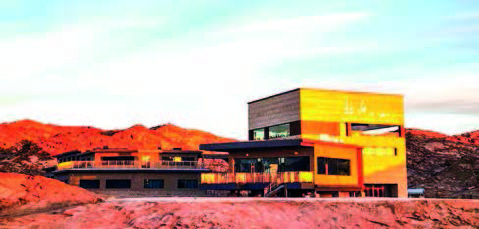Underground Research Laboratory, in the Gobi Desert’s northwestern region to conduct experiments on the final disposal of high-level radioactive waste. The project, overseen by the China Atomic Energy Authority, involves an investment exceeding 2.7 billion yuan and reaches a depth of 560 metres in Gansu Province.
China is building a deep underground laboratory in a hard and integrity granite in northwestern China’s Gobi Desert to facilitate experiments for the final disposal of high-level radioactive waste (HLW).
The Beishan Underground Research Laboratory, with a total investment of over 2.7 billion yuan (about 379 million US dollars) and a depth of 560 metres, is being constructed in the northwestern part of China’s Gansu Province, according to the China Atomic Energy Authority (CAEA).
About 99 per cent of the radioactive waste produced by the nuclear industry is classified as low- and intermediate-level radioactive waste, whose radioactivity decays to a harmless level after a few decades or a few hundred years, according to Wang Ju, the chief scientist in radioactive waste disposal of China National Nuclear Corporation (CNNC).
Potential threat to the environment
Only about one per cent of the remaining waste is HLW, which poses greater potential threat to the environment and should be disposed of safely for tens of thousands or even hundreds of thousands of years.
“After more than half a century of development of atomic energy technology, the safe disposal of HLW is becoming a common challenge to all countries in the nuclear industry,” Wang said.
At present, the method to dispose of HLW that has been widely accepted by the international community is to bury HLW in a stable geological -formation about 500 to 1,000 metres deep underground to achieve isolation of it for more than 10,000 years.
When Wang started to look for the site for China’s HLW repository in the 1990s, he had no idea the search would last for nearly three decades.
The site selection has very strict requirements. Wang and his team have travelled all over the potential sites in northwest China. They drilled about 100 deep boreholes in more than 20 years, with the drill cores they obtained adding up to 60 kilometres long.
The team found Beishan as the ideal site. Located in northwest China’s Gobi Desert, Beishan covers an area as large as south China’s Hainan Province, with a dry climate and scarce groundwater. It sits on granites aged about 260 million years, which forms an area with low chance of crustal movement.
In Beishan, Wang led the team to find a granite mass with integrity with an area equivalent to half of Beijing city.
“I’ve never seen a rock mass with such excellent integrity. The more integrity the rock mass is, the better natural barrier can be formed for HLW.”
Experts at home and abroad who had visited Beishan believed that it is one of the candidates for HLW repository with the best comprehensive conditions in the world.
In 2011, Beishan was identified as the preferred candidate site for China’s HLW repository.
Wang proposed to build an underground laboratory in Beishan’s granites to evaluate the feasibility for HLW disposal, which was also approved by the authorities later.
A “three-step” strategy
China has formulated a “three-step” strategy for the disposal of HLW, from site selection to building an underground laboratory, and then to the construction of a final repository. The ultimate goal is to build a repository around 2050. The construction of the Beishan Underground Research Laboratory was started in June 2021.
In order to construct this grand project, Wang’s team brought together talent from different professional backgrounds such as geology, rock mechanics, underground engineering, hydrogeology and geochemistry.
Chen Liang, an underground engineering expert, gave up his tenured position at the Centrale Nantes in France, and joined Wang’s team in the Gobi Desert.
“The project for the disposal of HLW could give full play to what I have learned. Solving this problem is of great importance to the country, and my life will become more meaningful in contributing to this cause,” Chen said.
Working in the uninhabited areas with the biting wind in winter, scorching heat in summer, as well as frequent sandstorms, Chen and his teammates conducted a large number of experiments on the characteristics of the rocks to verify the safety of the underground engineering construction.
Ji Ruili, who has worked in Beishan for more than 20 years, conducted borehole hydrological experiments. “We need to detect deep groundwater precisely, which is of great importance to the permanent safety of HLW repository.”
Green energy solution
Ji who is a father of a son and a daughter said: “We need to provide a complete green energy solution without radioactive risk for our next generation”.
The depth of the Beishan lab will exceed the height of Beijing’s tallest building. It is the first project in the world to excavate a spiral tunnel in the deep, extremely hard rock by using a tunnel boring machine.
“The traditional method of drilling and blasting will cause greater damage to the surrounding rock. To minimize the damage to the rock and ensure the stability and safety of the underground tunnels, we plan to grind down the rock by mechanical excavation,” said Chen Liang, now in charge of a geological research institute under the CNNC and deputy chief designer of the laboratory.
The laboratory, expected to be completed in 2028, will become the largest underground lab with the most functions in the field of HLW disposal in the world, providing an experimental platform and support for the final safe disposal of HLW in China, and contributing Chinese wisdom to solving this challenge facing the world.
SOURCE: Xinhua



